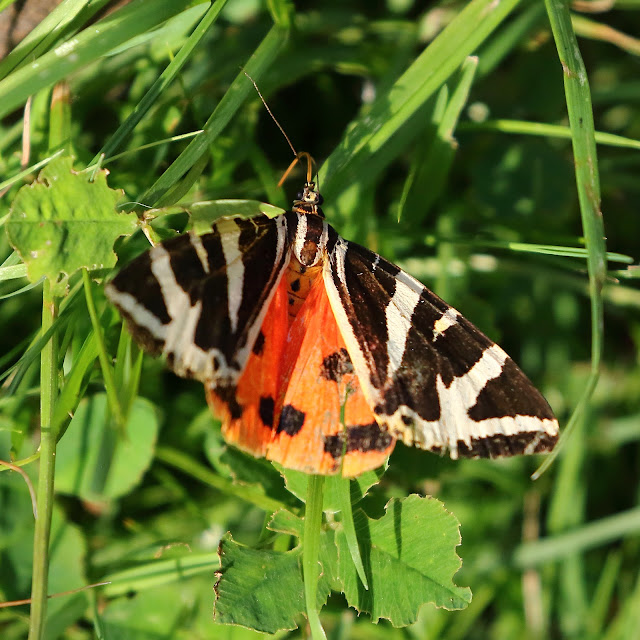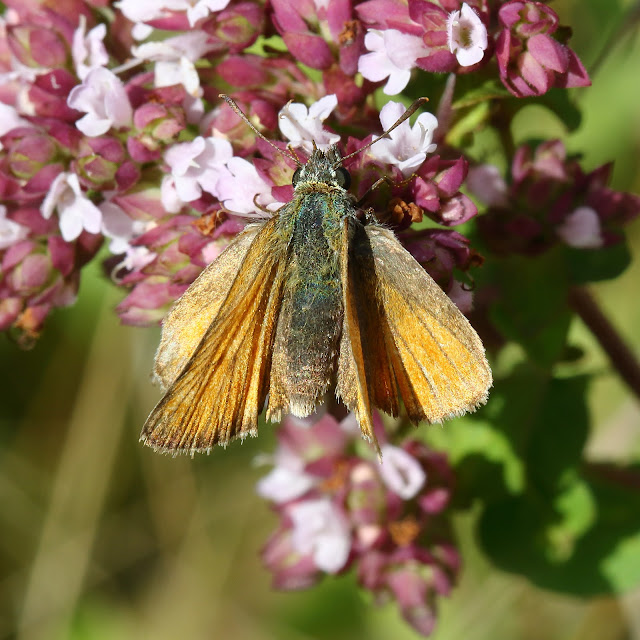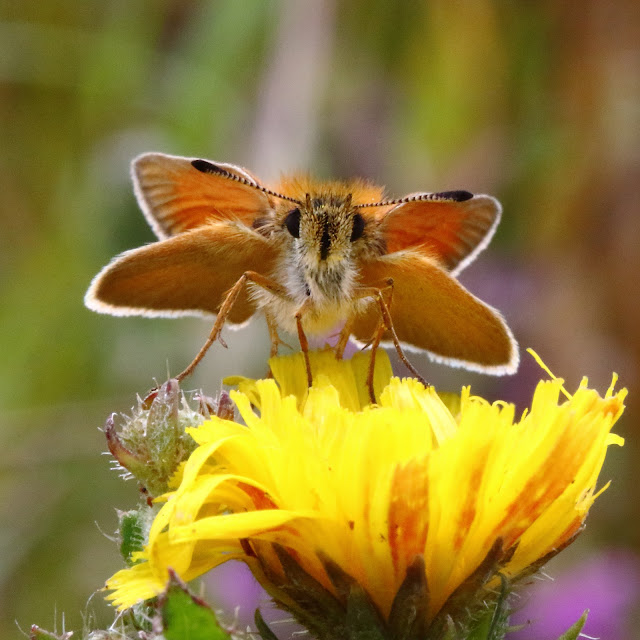August 2023
Amphibians
and Reptiles
It was good to get a few sightings of
froglets which were seen mainly in long grass.
Common Frog - a froglet was seen in Lt. Abington
church yard on 11th and 13th, with five further sightings in Great Abington
gardens later in the month.
Common Toad - one in Pampisford Rd garden (see blog)
Birds
A generally quiet
month, as is often the case in August, with a total of 44 species reported in 239
records. The local Swift have departed, and Swallow and House Martin have been
seen gathering in flocks in readiness. Both Great Crested and Little Grebe have
breed successfully on the GP lake, and both Little Egret and Kingfisher were
seen along the river.
The Swift
nesting in Hall Farm had fledged by 5th, and of the two further sightings
overhead, that on 19th is likely to be the last for this year. An increase in House
Martin numbers, 8-12 seen around Hall Farm and Mortlock Gdns later in the
month, suggests that their young have also now fledged, and Swallow were
reported gathering in flocks of around 20 on the LSA.
The two adult Great
Crested Grebe on GP lake were seen with just two young on 27th, and both an
adult and a juvenile Little Grebe were also seen there on the same date (see
blog). Four Barnacle Goose and around 50 Mallard were
also reported around the lake.
Unusually, a Little
Egret was seen visiting a garden pond along the High St, and along the
river, two Kingfisher were seen near the cricket pitch (14th). A Grey Wagtail was spotted by the
Recreation Gd on 31st, and good numbers of Pied Wagtail were seen in
paddocks on the LSA.
Buzzard,
usually one but up to three, were reported several times from around the
village, with a Kestrel seen gathering prey from the cricket pitch,
likely a worm (see
blog), a Sparrowhawk was seen along the ORC on 7th, and a Tawny
Owl continues to be seen in a garden at Hall Farm. Unusually, there were no
reports of Red Kite this month.
A Chiffchaff
was reported twice, on the ORC and on GP, and a Common Whitethroat
was seen, again twice, along the ORC and along North Rd. Also along the ORC, a
pair of Linnet and a Yellowhammer were seen on 7th.
The number of Blue
Tit and Great Tit seen visiting gardens has increased dramatically
towards the end of the month, with mixed flocks of 20-30 being seen, with the
young birds starting to develop more adult-looking plumage now. These flocks
also occasionally included 1-2 Coal Tit and Long-tailed Tit and a
Goldcrest was spotted on Hall Farm.
Goldfinch and Greenfinch
were regularly seen on feeders, with a flock of 20 Goldfinch seen on GP,
but only one report of a Chaffinch, on 27th in a Cambridge Rd garden.
Small numbers of both Wren and Dunnock were regularly reported,
as were Robin which could be heard singing again towards the end of the
month. A few House Sparrow were seen in Lewis Cres, and a flock of 10-20
Starling was spotted on the paddocks of the LSA. Small numbers of Blackbird
were also seen regularly.
A Great Spotted
Woodpecker was seen in gardens on Cambridge Rd and Hall Farm, and similarly
a Green Woodpecker was occasionally seen, with a young one spotted on
Cambridge Rd. Magpie were regularly seen with up to seven seen on Hall
Farm, and a Jay was also reported. Carrion Crow, Rook and Jackdaw
were also widely seen, the latter two in good numbers along the ORC.
A pair of Pheasant,
seen regularly in a Cambridge Rd garden, appeared with seven young this month (see
blog). Both Collared Dove and Stock Dove were seen in
several gardens, and Woodpigeon were widely reported.
Insects
This month 29 species were recorded in a total of 151 reports, and of
these 129 reports were of butterflies, 7 of bees, 6 of odonata and 9 of other
species.
Butterflies – Interestingly, a Wall Brown was reported this month,
the first record in the Abingtons. This widespread species, which fluctuates in
abundance but is becoming increasingly scarce inland, generally favours sunny stony
habitats, such as railway embankments, field edges, open grassland and gardens,
with the second brood generally peaking in August. An unidentified species of Fritillary
was also seen along the ORC.
Otherwise relative to July, the reporting of many species remained very
similar, namely: Brimstone, Common Blue, Gatekeeper, Small
Tortoiseshell, Speckled Wood, Small Skipper and Essex Skipper
(see blog).
Interestingly, Brown Argus reports were up (with 20+ being seen
along the ORC on 7th, see blog), as
were those of Holly Blue, both in keeping with the expected peak abundance
of the second brood this month. Other species showing a large increase in reports,
relative to July, were: Peacock, Large White and Small White,
again in keeping with the second brood emergence. Red Admiral reports
were also well up, this corresponding to the emergence of the new generation of
this migrant species (see blog).
Conversely, reports of Meadow Brown, Green-veined White
and Comma were all down, relative to July. The former two species start
to decline during August and Sept, and the Comma typically shows a gap
between broods in August.
The number of butterfly reports were: Red Admiral 22, Small White 21,
Large White 13, Brimstone 11, Meadow Brown 10, Gatekeeper 9, Peacock 9, Holly
Blue 9, Comma 6, Brown Argus 4, Speckled Wood 4, Common Blue 3, Green-veined
White 3, and 1 each of Small Tortoiseshell, Wall Brown and a Fritillary spp.
Odonata – both Emperor Dragonfly and Migrant Hawker were
reported twice, both from a Lewis Cres garden. A pair of Common Darter
was seen once around a Bourn Bridge Rd pond (see blog), and a
Southern Hawker was spotted in a Cambridge Rd garden.
There were also reports of Buff-tailed Bumblebee, White-tailed
Bumblebee and Common Carder Bee, as well as a Beefly. Several
Hummingbird Hawkmoth were seen, and the rather striking Jersey Tiger
Moth was seen in several gardens late in the month (see blog). A Dock
Bug was also reported.
Mammals
Bat – seen
regularly in a Cambridge Rd garden throughout the month, and also in Lewis
Crescent, all probably Pipistrelle. A bat nursery was reported in Hall Farm
with up to 60 bats seen flying out at dusk.
Hedgehog – two
seen together on a trail camera in a Bourn Bridge Rd garden regularly
throughout the month.
Muntjac – one
by the Perse fields on 26th, and one near Hall Farm seen with two Magpie
sitting on its back on 20th (see
blog).
Flora
and Fungi
No reports this month.
Rivercare
The regular river
sampling session was held at Abington Ford on 24th (see
blog).
Weather
Rainfall was recorded
at 47.75 mm, so again about double the average. The highest temperature was
recorded on the 10th at 31.2 degrees C, but the overall monthly average was in
the mid-twenties. The lowest temperatures was 5.5 degrees C on the 31st, but this
was exceptional as the overall minimum temperature was around 12 degrees C.
Winds were mainly south westerly veering to north westerly for the last week of
the month.
Many thanks to all those who contributed
reports of their sightings for August 2023:
Peter
Brunning, David & Gaynor Farrant, Gordon Hannah, Emma Jones, Len Mead, Andy
& Polly Merryweather, Mary Miles, Nancy Ockendon, Marion Rusted, Gill
Smith, Maggie & John Turner, Derek Turnidge, John Webb.








































